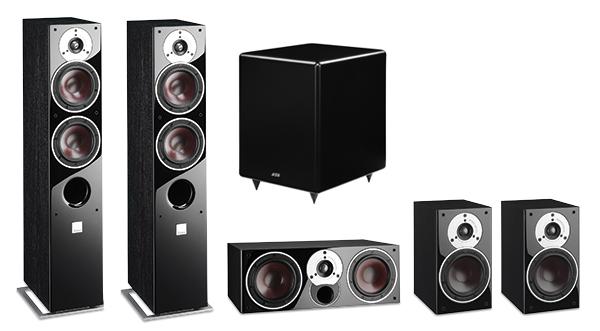The photos in the article are incorrect (again). That is not the VTF1-mk2 as described in testing, its the VTF15H-mk2
DALI Zensor 5 Speaker System and Hsu Research VTF-1 MK2 Subwoofer Reviews

AT A GLANCE
Plus
Neutral balance
Excellent center-L/R tonal match
Superb “small”-sub output and extension
Minus
Zensor 5 mini-towers are rather short
THE VERDICT
Combining DALI’s fine-performing, high-value two-way line with one of the best inexpensive 10-inch subwoofers available creates an affordable system that competes well with the many contenders in its price class.
DALI is a company that has nothing to do with surrealist art or Tibetan Buddhism. The acronym is for Danish Audiophile Loudspeaker Industries, which over some 30 years has grown from a home-market specialist to a respected international brand. Despite this success, I had never gotten up close and personal with any DALI designs (trade-show demos excepted) until they shipped us a representative selection of their new Zensor entry-level series. Since the Zensor-ship currently lacks a subwoofer, we tapped one of the best size- and price-appropriate designs we know, Hsu Research’s affordable VTF-1 MK2.
Of the five current Zensor models, we sampled three: the Zensor 5 mini-tower, for left and right; the Zensor Vokal center-channel speaker; and the Zensor 1 compact bookshelf pair, for the surround-channel positions. (The remaining Zensors are a larger tower and a larger bookshelf.) With the Hsu sub, this made for an attractively priced, sensibly scaled layout with an equally attractive system price of $2,244.
The Zensors, though designed and engineered in Denmark (they say so right on the cartons), are, like virtually all competitively priced speakers these days, manufactured in China. Notably, though, they are said to be built in a fully DALI-owned factory, one where DALI claims to make their own drivers, and where they operate day to day under the aegis of a Danish production manager and the same standards applied in their Danish factory.

The three models, all two-way designs, are conventionally constructed of MDF cabinets finished with woodgrain vinyl “wraps.” Along with the proprietary drivers, they’re equipped with substantial crossovers showing good-grade components. The designs are all simple, square-cornered boxes: unfancy and inexpensive, but nicely finished to an appearance of care and quality that isn’t faked.
Setup, Listening on Tilt
So far, so good. I deployed the DALIs in my long-established locations: the left and right Zensor 5s flanking my 52-inch LCD screen, the Zensor Vokal center on a low stand to reach the TV’s bottom edge, and the Zensor 1s on high shelves astride the listening position. Hsu’s VTF-1 MK2 subwoofer, itself another all-black box, went in my standard sub position, to the right of and behind the right-front mini-tower. All the Zensors have solid multi-way binding-post connectors, so hookup was simple and mechanically strong. With all six speakers connected and roughly balanced, I forgot about them and went about my business, letting a week’s worth of everyday casual music, movie, and TV fare accomplish any necessary break-in.
Settling down to attentive listening, and beginning as always with full-range stereo (subwoofer-less) playback, I quickly confirmed what I had noticed, visually, from the start: The Zensor 5 mini-towers are really short. Short enough, in fact, that their acoustical center was a good foot below the height of my ears when I was seated. The vertical dispersion was quite good, but this still left an audible loss of “air” when I sat up straight, compared with slumping down to the mini-towers’ own level. The fix was simple: I tilted the speakers substantially backwards, so that their listening axis aimed more toward my ears. DALI supplies the Zensor 5s with adjustable spikes (and rubber bumpers for wood floors), but to get the requisite height, I used three CD jewel cases stacked under each mini-tower’s front base-rail. This yielded a tilt of about 12 degrees—not enough to cause a jewel case to slide away, but not far off.

This made the Zensor 5s noticeably more open- and extended-sounding in my setup, and it permitted serious listening to continue, which showed these speakers to feature a very honest, natural tonal balance. Compared with my everyday monitors—long-discontinued two-way stand-mount Energy Veritas speakers, with similar total diaphragm area and enclosure volume—the Zensor 5s sounded slightly “darker,” and a subtle shade less airy (or perhaps less “depth-y”) is the better way to describe it. They didn’t go quite as low as the Energys (which are a paragon of small-speaker bass extension), and they offered just a bare touch of midbass warmth and didn’t quite equal the Energys on bass-timbre clarity, but otherwise the match was unexpectedly close. And this is praise indeed, since the Energys cost twice the Zensor 5s’ price, even back in the day.
Demanding material like “Why We Can” by Gordon Goodwin’s Big Phat Band (an HDtracks 96/24 download) showed off the Zensor mini-towers to good advantage. Their ability to project the complex musical textures of this big band—including not just the horns but the driving bass, all in a squeaky-clean, up-close recording perspective—was impressive and thus quite involving. I had no trouble “listening into” this busy, highly colored music, while big bass and drum transients came across with real authority. Stereo imaging was, as is fairly typical of small two-way designs, quite precise and stable, but a little less rich in front-to-rear depth and air compared with what you’d hear from some much more costly designs. I judged midrange clarity of strong solo elements (such as trumpet or female vocals) to be excellent, with a nice, solid (though modest) projection in front of the image, as well as a reliably clean, coherent tonality, even at substantial volumes.
- Log in or register to post comments
































































